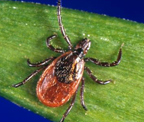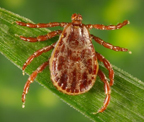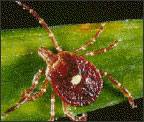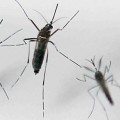
12 Tickborne Diseases
In our last post, we covered how ticks can cause an allergic reaction to red meat. Here are 12 other diseases spread by ticks throughout the U.S., via the CDC:
1. Anaplasmosis
Anaplasmosis is transmitted to humans by tick bites primarily from the blacklegged tick (Ixodes scapularis) in the northeastern and upper midwestern U.S. and the western blacklegged tick (Ixodes pacificus) along the Pacific coast. It’s caused by the bacterium Anaplasma phagocytophilum. Of the four distinct phases in the tick life-cycle (egg, larvae, nymph, adult), nymphal and adult ticks are most frequently associated with transmission of anaplasmosis to humans. Typical symptoms include: fever, headache, chills, and muscle aches. Usually, these symptoms occur within 1-2 weeks of a tick bite. Anaplasmosis is initially diagnosed based on symptoms and clinical presentation, and later confirmed by the use of specialized laboratory tests. The first line treatment for adults and children of all ages is doxycycline.
2. Babesiosis
Babesiosis, or babesia, is caused by microscopic parasites that infect red blood cells. Most human cases of babesiosis in the U.S. are caused by Babesia microti. Babesia microti is transmitted by the blacklegged tick (Ixodes scapularis) and is found primarily in the Northeast and upper Midwest; usually peaking during the warm months. Although many people who are infected with Babesia do not have symptoms, for those who do effective treatment is available. Babesiosis is preventable, if simple steps are taken to reduce exposure to ticks. Symptoms are similar to Lyme disease, though it typically begins with a high fever with chills. Patients my later develop fatigue, headache, sweats, muscle aches, nausea, and vomiting. It can threaten lives of those with no spleen, the elderly, or those with otherwise weak immune systems.
3. Lyme Disease
Lyme disease is transmitted by the blacklegged tick (Ixodes scapularis) in the northeastern U.S. and upper midwestern U.S. and the western blacklegged tick (Ixodes pacificus) along the Pacific coast. It’s caused by the bacterium Borrelia burgdorferi. Typical symptoms include fever, headache, fatigue, and a characteristic skin rash called erythema migrans. If left untreated, infection can spread to joints, the heart, and the nervous system. Lyme disease is diagnosed based on symptoms, physical findings (e.g., rash), and the possibility of exposure to infected ticks; laboratory testing is helpful if used correctly and performed with validated methods. Most cases of Lyme disease can be treated successfully with a few weeks of antibiotics. The ticks that transmit Lyme disease can occasionally transmit other tickborne diseases as well.
4. Powassan Disease
Powassan disease (POW) is transmitted by the blacklegged tick (Ixodes scapularis) and the groundhog tick (Ixodes cookei). Cases have been reported primarily from northeastern states and the Great Lakes region. Approximately 50 cases of POW virus disease were reported in the United States over the past 10 years. Most cases have occurred in the Northeast and Great Lakes region. Signs and symptoms of infection can include fever, headache, vomiting, weakness, confusion, seizures, and memory loss. Long-term neurologic problems may occur. There is no specific treatment, but people with severe POW virus illnesses often need to be hospitalized to receive respiratory support, intravenous fluids, or medications to reduce swelling in the brain.
5. Colorado Tick Fever
Colorado tick fever (CTF) is caused by a virus transmitted by the Rocky Mountain wood tick (Dermacentor andersoni). It occurs in the the Rocky Mountain states at elevations of 4,000 to 10,500 feet. Cases occur primarily in Colorado, Utah, Montana, and Wyoming. Symptoms include fever, chills, muscle pain, headache, fatigue, and some patients develop a rash. 50% of patients exhibit a biphasic illness, where patients’ symptoms disappear after 2-4 days and recur 1-3 days later.
6. Rocky Mountain spotted fever (RMSF)
Rocky Mountain spotted fever (RMSF) is a tickborne disease caused by the bacterium Rickettsia rickettsii. This organism is a cause of potentially fatal human illness in North and South America, and is transmitted to humans by the bite of infected tick species. In the United States, these include the American dog tick (Dermacentor variabilis), Rocky Mountain wood tick (Dermacentor andersoni), and brown dog tick (Rhipicephalus sanguineus). Typical symptoms include: fever, headache, abdominal pain, vomiting, and muscle pain. A rash may also develop, but is often absent in the first few days, and in some patients, never develops. Rocky Mountain spotted fever can be a severe or even fatal illness if not treated in the first few days of symptoms. Doxycycline is the first line treatment for adults and children of all ages, and is most effective if started before the fifth day of symptoms. The initial diagnosis is made based on clinical signs and symptoms, and medical history, and can later be confirmed by using specialized laboratory tests.
7. 364D Rickettsiosis (Rickettsia phillipi, Proposed)
364D Rickettsiosis is transmitted to humans by the Pacific Coast tick (Dermacentor occidentalis). This is a new disease that has been found in California. In addition to Rickettsia rickettsii, the agent of Rocky Mountain spotted fever (RMSF), several other tick-borne species of Rickettsia, broadly grouped under the heading “Spotted Fever group Rickettsia (SFGR)” have been shown to cause human infections. Tick-borne SFGR are transmitted to humans by the bite of an infected tick, and may cause similar signs and symptoms to those observed for RMSF.
8. Ehrlichiosis
Ehrlichiosis is transmitted to humans by the lone star tick (Ambylomma americanum), found primarily in the southcentral and eastern U.S. Ehrlichiosis is the general name used to describe several bacterial diseases that affect animals and humans. Human ehrlichiosisis a disease caused by at least three different ehrlichial species in the United States: Ehrlichia chaffeensis, Ehrlichia ewingii, and a third Ehrlichiaspecies provisionally called Ehrlichia muris-like (EML). Ehrlichiae are transmitted to humans by the bite of an infected tick. The lone star tick (Amblyomma americanum) is the primary vector of both Ehrlichia chaffeensis and Ehrlichia ewingii in the United States. Typical symptoms include: fever, headache, fatigue, and muscle aches. Usually, these symptoms occur within 1-2 weeks following a tick bite. Ehrlichios is diagnosed based on symptoms, clinical presentation, and later confirmed with specialized laboratory tests. The first line treatment for adults and children of all ages is doxycycline.
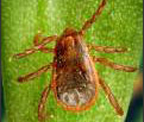
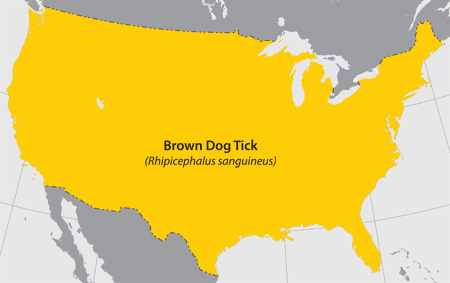
9. Heartland Virus
Infection has been identified in eight patients in Missouri and Tennessee as of March 2014. Studies suggest that Lone Star ticks may transmit the virus. It is unknown if the virus may be found in other areas of the U.S. Heartland virus belongs to a family of viruses called Phleboviruses. Most of the phleboviruses that cause people to become ill are passed through the bite of a mosquito, tick, or sandfly. It is not yet fully known how people become infected with Heartland virus. However, recent studies suggest that ticks, namely Lone Star ticks, may transmit the virus. It is unknown at this time if the virus may be found in other areas of the United States. Since Heartland virus disease was first described in 2012 and there have only been a few cases, scientists are still learning about it. So far, all patients diagnosed with Heartland virus disease became sick during May-September. They all had a fever and felt very tired. Some also complained of headaches, muscle aches, diarrhea, losing their appetite, or feeling sick to their stomach. They all had low numbers of cells that fight infection and that help blood clot. Most patients required hospitalization for their illness. Most patients fully recovered, but one patient died. Heartland virus may easily be misdiagnosed as ehrlichiosis.
10. STARI (Southern Tick-Associated Rash Illness)
A rash similar to the rash of Lyme disease has been described in humans following bites of the lone star tick, Amblyomma americanum. The rash may be accompanied by fatigue, fever, headache, muscle and joint pains. This condition has been named southern tick-associated rash illness (STARI). The cause of STARI is not known.
11. Tickborne Relapsing Fever (TBRF)
is transmitted to humans through the bite of infected soft ticks. TBRF has been reported in 15 states: Arizona, California, Colorado, Idaho, Kansas, Montana, Nevada, New Mexico, Ohio, Oklahoma, Oregon, Texas, Utah, Washington, and Wyoming and is associated with sleeping in rustic cabins and vacation homes. Relapsing fever is bacterial infection characterized by recurring episodes of fever, headache, muscle and joint aches, and nausea. It is caused by certain species of Borrelia spirochetes.
12. Tularemia
is transmitted to humans by the dog tick (Dermacentor variabilis), the wood tick (Dermacentor andersoni), and the lone star tick (Amblyomma americanum). Tularemia is caused by the bacterium Francisella tularensis. Rabbits, hares, and rodents are especially susceptible and often die in large numbers during outbreaks. Humans can become infected through several routes. In the United States, naturally occurring infections have been reported from all states except Hawaii.

